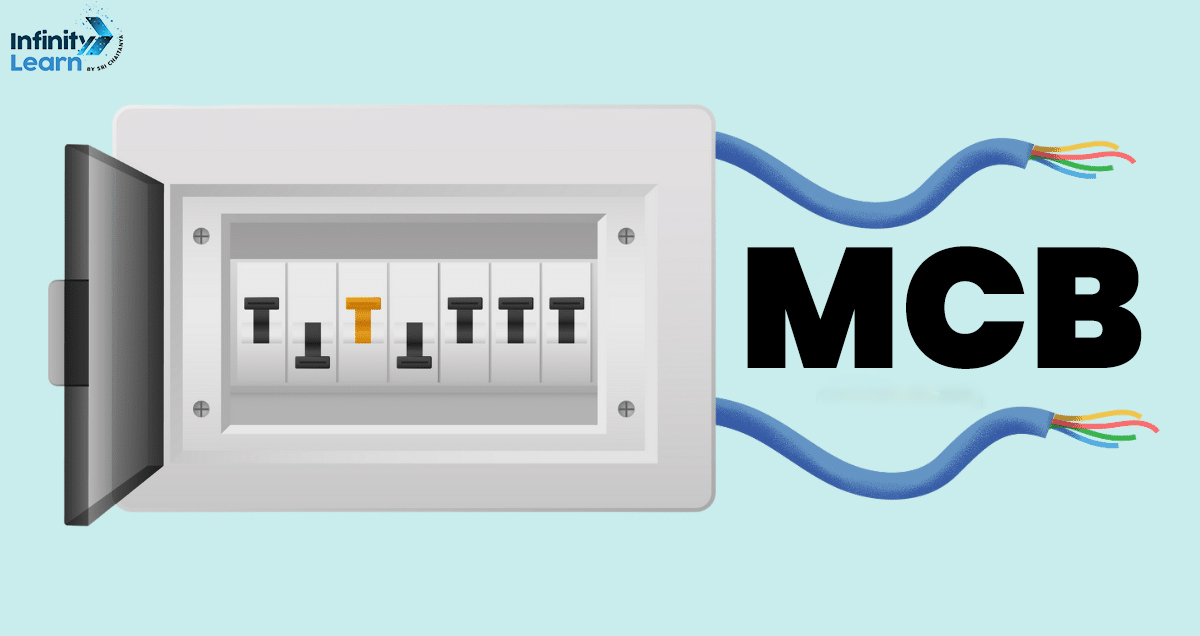Table of Contents
MCB – Miniature Circuit Breaker: Whenever one is choosing electrical appliances, safety is to be the first concern. Whenever a circuit fails or excess current flows, it causes damage, resulting in an overload or short circuit. Therefore it is necessary to incorporate a device as a safety element which can provide overcurrent protection to the electrical devices and circuits.
We have always heard about the fuse in our classes. Fuses are the most common device used early to protect the circuit. A fuse is a metal wire or strip that melts when current overflows, breaking the circuit and protecting it from the short circuit. In modern days, the fuse has been replaced by a much more efficient and small electronic device. It is known as MCB – Miniature Circuit Breaker.

What is MCB?
As we just read above, MCB is a device that protects from the overcurrent flow in the circuit. If a short circuit happens, just imagine what will happen to your household devices, such as a fan, washing machine, oven and more. These devices will burn and lead to much bigger tragedies. Therefore, to avoid these, safety instruments like MCB are used.
MCB full form
MCB full form is Miniature Circuit Breaker. A Miniature Circuit Breaker is precisely an automatic switch that opens when excess current flows through the circuit. MCB can be reclosed without any manual replacement. But in the case of a fuse, it needs to be replaced or rewired once it has been operated. Hence, the fuse is known as one of the sacrificial devices.
Therefore, this is the main reason why MCBs are used as an alternative to the fuse in most of the circuits. Also, whenever there is a circuit fault, the MCB switches automatically shut down. Also, it makes it easy to detect the fault of the device.
MCB Box
MCB is relatively safe and can be easily handled. It also quickly restores the supply. MCB, Miniature Circuit Breaker, can be reset quickly and has relatively lower maintenance costs. MCB works on a bi-metal respective principle. It basically protects against overload current and solenoid short circuit current.
Components of MCB
The components of the MCB are listed below:
- Latch
- Solenoid
- MCB Switch
- Plunger
- Incoming Terminal
- Arc Chutes Holder
- Arc Chutes
- Dynamic Contact
- Fixed Contact
- Din Rail Holder
- Outgoing Terminal
- Bi-metallic Strip Carrier
- Bi-metallic Strip
Working Principle of an MCB
Miniature Circuit Breakers (MCBs) play a crucial role in electrical distribution systems, safeguarding circuits and electrical appliances from overloads and short circuits. The working principle of an MCB involves a bimetallic strip within the device. When the current exceeds the rated capacity, the bimetallic strip heats up, causing it to bend and ultimately trip the circuit breaker. This rapid response to overcurrent conditions helps prevent damage to wiring and equipment.
MCBs also feature a magnetic trip mechanism, which responds to sudden, high-intensity surges by quickly opening the circuit. This dual-trip mechanism ensures reliable protection against both gradual overloads and abrupt short circuits. MCBs are widely used due to their compact size, easy reset capability, and efficiency in isolating faulty circuits, making them an essential component in modern electrical systems.
Types of MCB
MCB trip curve decides the type of MCB that shall be used for different devices.
There are 6 types of MCBs, they are:
- A Type
- B Type
- C Type
- D Type
- K Type
- Z Type
A Type MCB:
A Type MCB trips off the circuit when the current exceeds the twice or thrice limit of the actual current rating. A type MCB is highly sensitive to the short circuit. Hence, it is moderately used in the manufacturing of semiconductors.
B Type MCB
B Type MCB trips off the circuit when the current exceeds the current flow by 3-5 times. We can spot the application of B Type MCB in cable protection.
C Type MCB
C Type MCB trips off the circuit if the current exceeds 5-10 times the actual current flow. C Type MCB is used in domestic as well as commercial appliances like transformers, computers, servers, and more.
D Type MCB
D Type MCB trips off the circuit if the current flow exceeds 10-20 times the actual current flow. It offers high resistance. It is used in motors.
K Type MCB
K Type MCB can withstand up to 8-12 times the current flow. It is widely finds used in heavy-duty load devices. Examples of its applications are compressors, X-ray machines, etc.
An MCB is a simple, easily operable device and requires low maintenance too. MCB can be easily replaced without creating a lot of mess.
Uses of MCB
MCB is the key component for the safety and efficient functioning of electric machines. MCB is used in most electrical appliances that are mainly used for industrial or domestic purposes. In domestic usage, appliances like lights, heaters, and fans require MCB to check and protect the connection constantly. It helps in the prevention of short circuits and accidents.
MCB Prices
There are many companies that manufacture MCBs. The MCB Price depends on various factors including its durability, material, type and more. Average starting price for an MCB is 150 INR in India and may go to about 2000 INR.
FAQs on MCB
What is MCB?
MCB, a Miniature Circuit Breaker, is a device that protects from the overcurrent flow in the circuit. MCB automatically switchs off if excess current flows
What is the full form of MCB and RCCB?
MCB stands for Miniature Circuit Breaker, while the full form of RCCB is Residual Current Circuit Breaker
How many types of MCB are there?
There are at least 6 types of MCBs available. These are A, B, C, D, K and Z type of MCB.
On which mechanism does an MCB work?
MCB works on electro-mechanical mechanisms.









